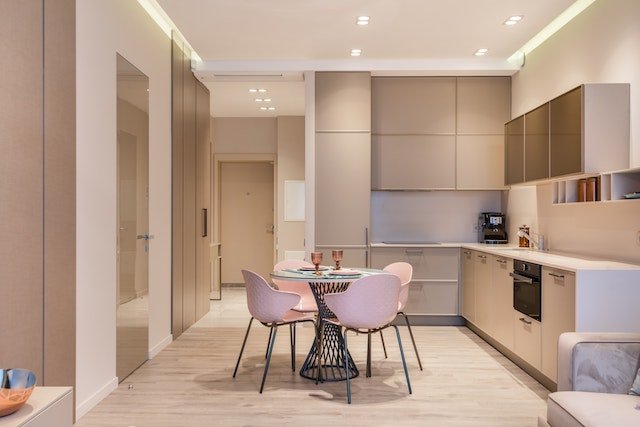If you’re a homeowner in the Teaneck area and looking for some fresh inspiration to upgrade your living space, you’re in luck! Home renovation can not only breathe new life into your home but also add value to your property. There are plenty of options to consider, from minor cosmetic changes to major structural renovations, depending on your needs, budget, and preferences.
Here are some of the best home renovation ideas that can help transform your home into your dream space in the Teaneck area.
How Renovating Your House Will Maximize Its Beauty?
Renovating your home can bring a multitude of benefits to both its aesthetics and functionality. By updating the design, you can transform an outdated or old-fashioned space into a modern and stylish one.
This can involve replacing old finishes and fixtures, such as countertops, cabinets, and flooring, or changing the layout to create an open-plan living area, a larger kitchen, or more storage space. These updates can significantly enhance the overall look and feel of your home, making it more inviting and enjoyable to live in.
Improving the layout is another key way that renovating can maximize your home’s beauty. If the layout is impractical or doesn’t suit your lifestyle, renovating can allow you to reconfigure the space to better fit your needs. For example, removing a wall to open up the kitchen to the living area can create a more spacious and connected feeling, while adding an ensuite bathroom to the master bedroom can make the space more luxurious and functional.
Enhancing your home’s curb appeal is also important. Renovating the exterior can help create a more welcoming and attractive appearance, which can add to the home’s overall beauty. This could involve adding new siding, painting the exterior, or landscaping the front yard to create a more inviting entrance.
What Are the Different Types of Renovation?
Cosmetic Renovation
Cosmetic renovation refers to making changes to the appearance of a space without altering its structure. It involves making superficial changes that can enhance the aesthetics of a room, such as repainting walls, updating lighting fixtures, replacing old curtains or blinds, installing new flooring, or adding decorative elements like artwork or accessories.
Cosmetic renovation is a cost-effective way to improve the look and feel of a space without spending too much money or disrupting the home’s structure. It can be a great option for homeowners who want to refresh the look of their home, without the expense and hassle of a major renovation.
Kitchen and Bathroom Renovation
Kitchen and bathroom renovations are among the most common types of home renovations. These areas are essential to the functioning of a home, and updating them can significantly improve their functionality, aesthetics, and overall value.

Kitchen renovations typically involve upgrading appliances, cabinetry, countertops, and flooring. Many homeowners opt to create an open-concept kitchen layout by removing walls, which can make the space feel larger and more welcoming. Other popular kitchen renovation projects include adding a kitchen island or a breakfast bar, upgrading lighting fixtures, and installing new backsplash or tiles.
Bathroom renovations often involve updating fixtures such as sinks, toilets, and showers, as well as upgrading the flooring, countertops, and cabinetry. Many homeowners opt to add features like heated floors, a spa-like shower system, or a bathtub with jets to create a more luxurious experience.
Structural Renovation
Structural renovation involves making significant changes to the layout or construction of a home. This type of renovation often requires a professional contractor or architect and can be more expensive and time-consuming than cosmetic renovations.
Structural renovation projects can include removing walls to create an open-concept layout, adding new rooms or levels to a home, or changing the flow of a space to create a more functional layout. These renovations can also involve upgrading electrical, plumbing, or HVAC systems to accommodate the changes.
Outdoor Renovation
Outdoor renovation involves making changes to the exterior of a home, including the landscaping, patio or deck, driveway, and entryway. These renovations can enhance the home’s curb appeal and create a more inviting outdoor living space.
Some popular outdoor renovation projects include adding new landscaping, such as planting new trees or flowers, building a new deck or patio, installing a new outdoor lighting system, and updating the driveway or walkway with new pavers or stones. These projects can significantly improve the appearance of a home’s exterior and create an outdoor space that is perfect for entertaining or relaxation.
Energy-Efficient Renovation
Energy-efficient renovation involves making changes to a home that reduce its energy consumption and carbon footprint. These renovations can help homeowners save money on energy bills while also reducing their impact on the environment.
Some popular energy-efficient renovation projects include upgrading insulation, sealing air leaks, installing energy-efficient windows and doors, and upgrading to energy-efficient appliances and lighting fixtures. These changes can significantly reduce a home’s energy usage, making it more sustainable and cost-effective.
Restoration Renovation
Restoration renovation involves bringing a home back to its original state or historic appearance. This type of renovation is often necessary for older homes that have suffered damage or neglect over the years.
Restoration renovation typically involves preserving original features of the home, such as trim work, molding, windows, and doors, while repairing or replacing damaged elements. This can involve sourcing antique materials or working with skilled craftsmen who specialize in restoring historic homes.
How Do I Make a Renovation Checklist?
Making a renovation checklist can help you stay organized and focused throughout the renovation process. Here are some steps to create a comprehensive renovation checklist:
Define the scope of the renovation: Begin by defining the scope of the renovation project. Identify which rooms or areas of the house you plan to renovate and list out the specific changes you want to make. For example, if you are renovating your kitchen, your checklist might include items like replacing countertops, installing new cabinetry, and upgrading appliances.
Determine your budget: Set a realistic budget for the renovation project. This will help you prioritize which projects are most important and ensure you don’t overspend. Be sure to include a contingency fund in case unexpected expenses arise.
Research contractors and suppliers: Research contractors and suppliers for the renovation project. Get quotes from multiple contractors and suppliers to compare prices and ensure you are getting the best value for your money.
Create a timeline: Create a timeline for the renovation project, including start and end dates for each phase of the project. This will help you stay on track and ensure the project is completed within a reasonable timeframe.
Determine necessary permits: Determine if any permits are needed for the renovation project. Check with your local government office to find out what permits are required and ensure they are obtained before beginning the project.
Include details: Include details for each task on the checklist. This should include specific materials, colors, and finishes you want to use, as well as any special instructions or considerations for each task.
Prioritize tasks: Prioritize tasks on the checklist based on their importance and urgency. This will help you stay on track and ensure the most important tasks are completed first.
Keep the checklist updated: As the renovation project progresses, update the checklist to reflect any changes or adjustments to the plan.
By following these steps, you can create a comprehensive renovation checklist that will help ensure your renovation project is completed on time and within budget.
How Do You Renovate a Small House on a Budget?
Renovating a small house on a budget requires careful planning and creative solutions. Here are some tips to help you renovate a small house on a budget:
Prioritize: Start by making a list of what needs to be renovated in order of priority. Focus on essential repairs and improvements that will make the biggest impact on your home’s functionality and comfort.
Keep the layout: Avoid making any major changes to the layout of your home, as this can be expensive and time-consuming. Instead, focus on optimizing the existing space by reconfiguring furniture, adding storage solutions, and using multi-functional furniture.
Use cost-effective materials: Use cost-effective materials that look good and perform well. For example, instead of expensive hardwood flooring, consider using laminate or vinyl flooring that mimics the look of wood. Or, opt for low-cost options like ceramic tiles or linoleum for your bathroom or kitchen.
DIY where possible: Consider doing some of the renovation work yourself, such as painting or installing light fixtures. This can help you save money on labor costs.
Shop around: Look for deals on materials and supplies by shopping around at different stores and online. Don’t be afraid to negotiate prices with suppliers and contractors to get the best deal.
Repurpose and upcycle: Repurpose old furniture or household items to create new and functional pieces. For example, you can turn an old ladder into a bookshelf, or use an old dresser as a bathroom vanity.
Choose timeless designs: Avoid trendy designs that may go out of style quickly. Instead, choose timeless designs and neutral colors that will stand the test of time.
Focus on curb appeal: Improving the exterior of your home can make a big impact without breaking the bank. Consider painting the front door, adding window boxes, or planting a small garden to boost your home’s curb appeal.
Conclusion
Renovating a home can be an exciting project, but it can also be costly and time-consuming. Prioritizing tasks, using cost-effective materials, and doing some of the work yourself are all effective ways to save money while renovating a small house.
By being creative and strategic in your approach, you can achieve a stylish and functional space that meets your needs and fits within your budget. Remember to focus on what is most important and prioritize accordingly, and don’t be afraid to seek out deals and negotiate prices to get the best value for your money.
